Experiments
Science in the deep sea
developed by school children and executed by scientists during a cruise
The purpose of a scientific experiment is to find answers for specific questions. Often an experiment lasts long, is very complicated and expensive. We present you in detail some of the experiments we conducted during previous expeditions and new experiments conducted during this SOI cruise in 2023.

Class 5A (14 – 15 years old students, teacher Ulrike Randl-Gadora), AHS Rahlgasse, Vienna, Austria
Vent animals – Meat Munchers or Leaf Lovers?

Background: The animals living at the deep-sea hydrothermal vents of the volcano of the East Pacific Rise are well known. About 50 species bristle worms (Phylum Annelida, family Polychaeta), snails (Phylum Mollusca, family Gastropoda), a few mussels and clams (Phylum Mollusca, family Bivalvia) and a few crustaceans (Phylum Arthropoda, family Crustacea) are described in Desbruyeres D., Segonzac M., Bright M. 2006. Handbook of Deep-Sea Hydrothermal Vent Fauna. 2nd edition. Denisia 18, Landesmuseum Linz, Austria pp. 554. The diet of the vent animals is based on chemosynthesis. Some animals graze over the surfaces to feed on these chemosynthetic bacteria, other are filter feeder and collect the bacteria from the water. There are a lot of predators feeding on animals or scavengers feeding on dead animals. Others apparently are not picky and feed on dead and alive animals. Because of the lack of light in the deep sea, however, no plants live in the deep sea. Therefore, we expect animals are carnivores rather than vegetarians because this is the food they know. Further we believe that animals will prefer fat and proteins over carbohydrates, simply because animal carbohydrates are rather rare. Since proteins are mainly used as building blocks in metabolism and are only broken down as energy supply when carbohydrates and fat can no longer be metabolized, we assume that animals also prefer fat (even when we humans would rather eat a steak than a piece of pork fat). Ultimately, the closer the food is the faster they will find it, not with their eyes (which are useless in the dark) but by smell.
Hypothesis 1: We hypothesize that vent animals will prefer meat over plants.
Hypothesis 2: We hypothesize that vent animals prefer fats over proteins over carbohydrates.
Hypothesis 3: We hypothesize that vent animals will find food faster the closer it is.
Material and Methods: We use two kitchen oven grids and place on each three animal and three plant products on the grid and secure them with cable ties. On each corner of the oven grid, a 0.5 kg lead weight is mounted. We further use a labelled plastic bucket lid (already prepared in Vienna). The lid is secured with ropes to the gird prior deployment. Kitchen oven grid, lead, rope and buckets lids will be shipped from Vienna to Costa Rica.
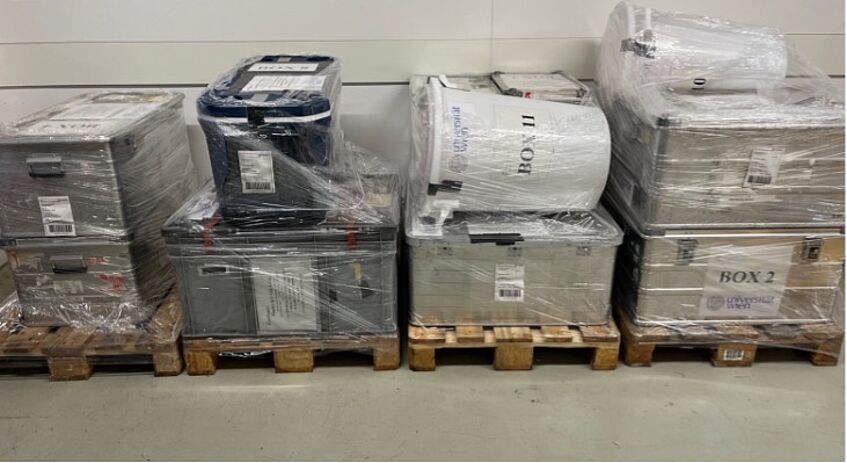
Somewhere in the 14 boxes shipped from Vienna to Costa Rica are the items for this experiment.
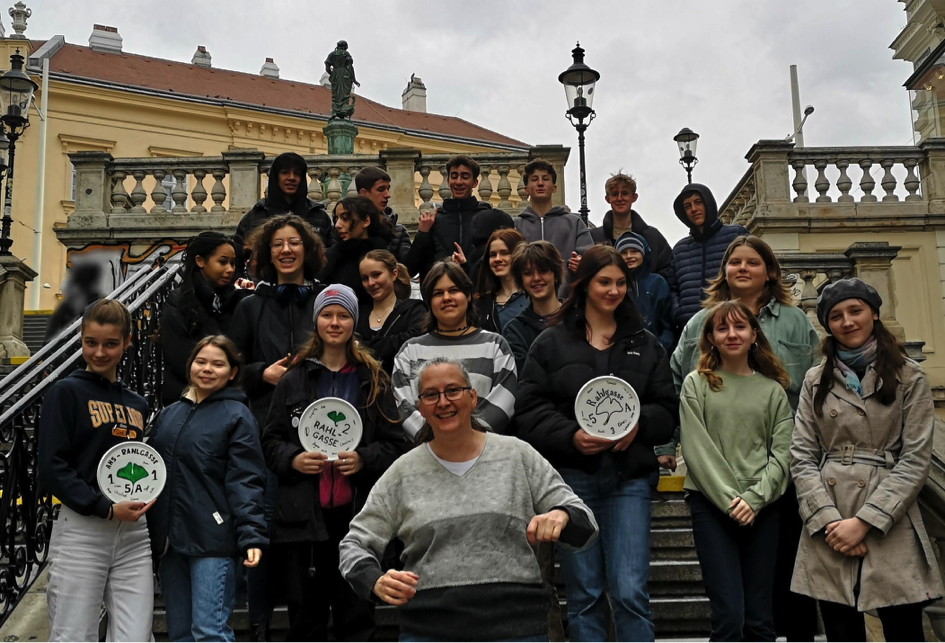
Labelled bucket lids
The following food items will be bought in Puntarenas, Costa Rica prior boarding the ship and stored in a refrigerator until the deployment: Animal pig rind (fat), muscle meat (protein), liver (carbohydrate), plant coconut fat or brazil nuts (fat), lentils or beans (protein), potato (carbohydrate).
Prior deployment in the crater of the volcano at 2500 m depth, the two grids with the food will be secured on the platform of the ROV SuBastian. One grid will be deployed in a vent area with a lot of animals, the other one on bare basalt a few meters away. Deployment will be filmed and still pictures will be taken. The plan is to visit this site a few hours after deployment and during the next days. The end of the experiments depends on 1) how fast animal find the food and eat it and 2) how often it will be possible to visit this deployment. At the end the scientists will use the multi-chamber suction sampler on the ROV to collect all animals on each food item separately. In the lab onboard the ship the animals will be fixed in ethanol and shipped back to Vienna for counting of animals and identification of animal species by the students of the 5A class.
Shopping tour in Costa Rica
Prior the research cruise in July 2023 scientists bought the following meat and veggies: fat, liver, nuts, chickpeas and potatoes. In addition, they also collected a net from the side of the road to use for mounting the food items on the kitchen grid.

The search for goods and net
Mounting of experiment
On board the ship, the food was mounted on the kitchen grid together with the markers from the school and some diving lead for adding weight. This happened very early in the morning prior deployment.

Work early in the morning to mount the food prior deployment
Travel to the depths of the Pacific Ocean
Finally, we brought the food in the crater of the volcano in about 2500 m depth. One deployment was on bare basalt with no visible animals present, the other one in the middle of warm vent with lots of animals.

Transport and deployment of experiments with ROV SuBastian, dive 548
3 hours after the deployment (548) the ROV re-visited the experiments for the first observation. Further visits were executed during the following 7 days except for day 1 and day 6 where we did not manage to visit.
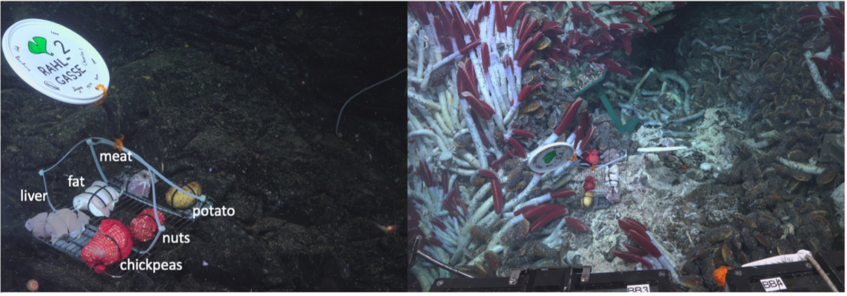
Dive 548 – left side bare basalt, right side warm vent
Analyses in Vienna
The students from the Rahlgasse then received then photos of the videos at the start of the new semester in September 2023. The identification of the animals was conducted by Monika Bright. The data analysis is based on the photos. The first photos (Day 0, dive 548) date three hours after the deployment of the grids at the two locations (basalt, deep-sea vent), with all subsequent photos taken at approximately the same time on the following days. There are no photos for Day 1 and Day 6. In total, five days were evaluated based on multiple photos per day: Day 0 (548), Days 2 to 5 (550 to 553), and Day 7 (555). For clarity, the missing days (highlighted in gray) are also included in the data table (Table 1).
Individuals were counted only if they touched the grid with the food offerings. Merely orienting towards the grid without touching it was not sufficient for counting purposes. If photos of a particular day showed different numbers of individuals of a species, the highest count was used. If the mouthparts of an individual were on a food source (fat, meat, liver, nuts, chickpeas, potatoes), it was assigned to that source. If this was not possible, the individual was counted as "Grid".
The winner is the squat lobster Munidopsis
Most often, the squat lobster of the genus Munidopsis was encountered, which is why in Table 1 only the number of individuals (without letters for the genus) is given. Identification at the species level was not possible here. The other two species, the crabs Bythogrea thermydron and Cyanagrea praedator, were each represented by only one individual and were therefore marked in the table without a count, but with the initial letter of their genus (B; C).
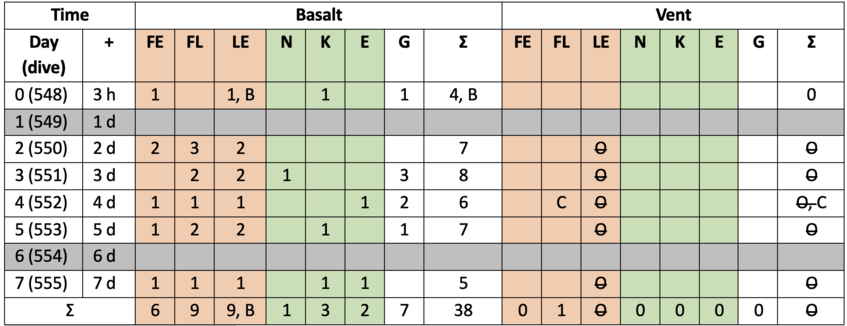
Raw Data and abbreviations
FE Fat, FL Meat, LE Liver (animal food sources highlighted in red)
N Nuts, K Chickpeas, E Potato (plant-based food sources highlighted in green)
G Grid. O No data available due to loss of liver. ©U. Randl-Gadora, E. Wiederhold
A total of 39 animals were counted at both sites combined, with 97.43% on basalt and 2.56% at the vent. 36 animals belong to the genus Munidopsis, accounting for 94.87%, exclusively present on basalt. Considering the occurrence of all 36 counted individuals of Munidopsis over the entire study period, a classic succession pattern emerges with few individuals at the beginning, many in the middle, and few at the end of the experiment (Fig. 1). This pattern approximates a normal distribution.

Photograph of Munidopsis spp. left side, dive 548 left side, distribution of counted individuals of Munidopsis spp. during the study period
One individual of the crab Bythogrea thermydron was found on basalt. Another single individual if the crab Cyanagrea praedator was detected at the vent site.

The rarely detected crabs Cyanagrea praedator from the vent, left side and Bythogrea thermydron from basalt, right side
Who ate the liver at the vent site?
Between the first and second photoshoots, the animal carbohydrate source was completely removed. It can be assumed that a large animal, likely a shark, a large bony fish, or an octopus, was responsible for this. However, since there are no photos of this event, this assumption cannot be proven.
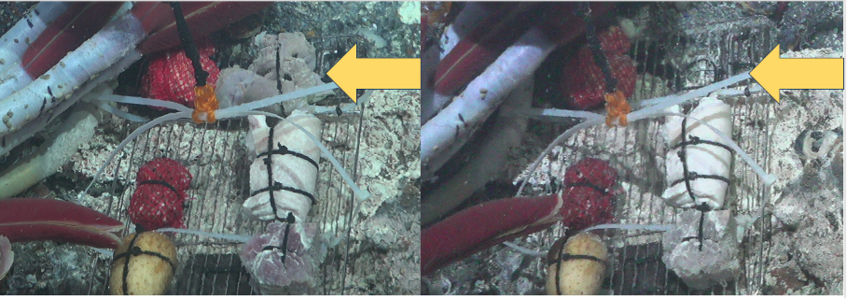
Photograph of liver at vent site 3 hours after deployment left side and same area of liver 2 days after deployment right side, see yellow arrows
When natural food is plenty, foreign food is not attractive
Since only a single animal was detected at the vent, the hypothesis that animals living near a deep-sea vent find or explore new food sources more quickly than animals living on bare basalt far from deep-sea vents is falsified. It is plausible that vent-dwelling animals have no incentive to seek out new food sources as long as sufficient natural food is available. It can be assumed that competition for food in the vicinity of a deep-sea vent only increases when the food supply diminishes.
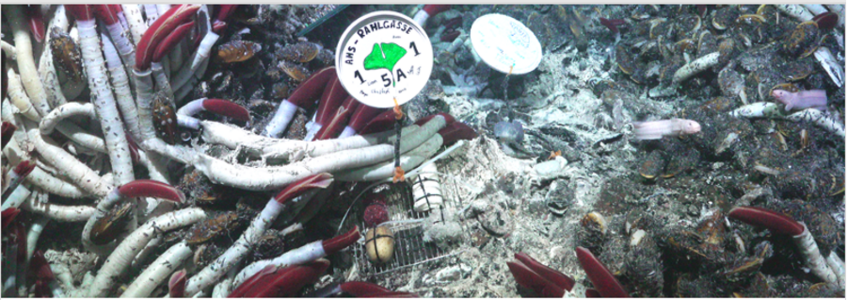
Photograph vent site experiment, dive 555 lacking animals interested in the foreign food
When food is scarce, foreign food is attractive
The bare basalt is an environment perceived “empty” to do the scarcity of large animals. This environment is also known to offer little natural food. Therefore, a new food source like our experimental food is attractive. Many animals were found directly sitting or feeding on the experimental food but also were seen in the vicinity of the experiment. It is likely perceived through olfactory cues. However, the extent to which competition for this food increases over time could not be investigated in this experiment.
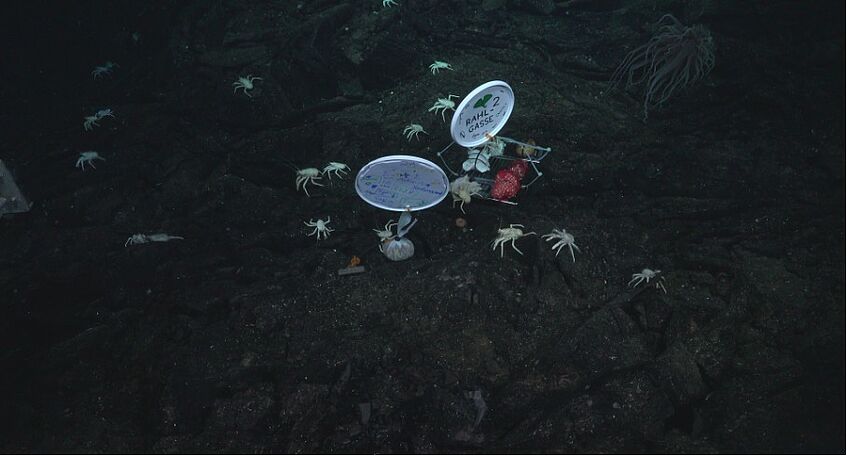
Photograph of basalt site experiment, dive 553 (Note that there was also another experiment conducated at this site.)
Munidopsis prefers to feed on what it knows
Overall, animal food sources were visited 80.6% of the time, by an average of 4 animals per day, while plant food sources were visited approximately 19.4% of the time, by one animal per day. A comparison between animal and plant food sources clearly demonstrates a preference for the former. Thus, the hypothesis that deep-sea animals prefer animal food over plant food can be verified.

Comparison of the preference of animal and plant food sources, left side ©U. Randl-Gadora; right animals on meat, fat and liver as well as on potato and chickpeas, dive 555
Munidopsis is on a high-carbohydrate diet
Fat sources were visited by only about 22% of individuals throughout the study period, while protein sources were visited by approximately 38%, with a greater range of variation. On average, carbohydrate sources were slightly more attractive than protein sources, at around 40%. This result seems to refute the hypothesis that fats are preferred over proteins and proteins over carbohydrates. Carbohydrates appear to be the most attractive, closely followed by proteins, with fats being the least attractive.
To verify whether the preference for carbohydrates applies equally to both animal and plant sources, we compared the animal and plant nutrients. It is evident that in both cases, fatty food sources exhibit the lowest preference. However, unlike animal sources, protein sources are preferred in the plant-based food offerings.
It should be noted that no feeding traces were detected on the potato and nuts, and the surface of the swollen and pre-cooked chickpeas did not provide clear indications. Therefore, it is questionable whether mere contact of mouthparts with a food source justifies the counting mentioned earlier. Detailed video recordings of at least five to ten minutes per individual and microscopic examinations of the surfaces would be necessary to clarify which food source is visited by which animal species and for how long, as well as whether an individual actually feeds there. It is recommended to take additional close-up photos and videos for a more precise evaluation to assess details sharply. Taking animals for an analysis of their stomach contents is not feasible for ethical reasons.
It should be noted that no feeding traces were found on the potatoes and nuts, and the surface of the soaked and precooked chickpeas also did not provide any clear evidence. Therefore, it is questionable whether mere contact of the mouthparts with a food source justifies the aforementioned count. Detailed video recordings of at least five to ten minutes per individual and microscopic examinations of the surfaces would be necessary to clarify which food source is visited by which animal species, for how long, and whether an individual actually feeds there. For a more precise evaluation, it is recommended to take additional close-ups and videos to be able to assess details clearly. Removing animals for analysis of their stomach contents is not advisable for ethical reasons.

Preference of protein, carbohydrates and fat of animal and plant food sources. ©U. Randl-Gadora
What can be done better in future?
It cannot be ruled out that the consistency of the food offerings had a significant influence on the results. The potato should not have been raw but cooked. The substantial difference between the fat sources used (nuts and bacon rind) could be minimized by using a package of plant-based butter or coconut fat instead of the nuts and a package of cow milk butter instead of the bacon rind.
At the same time, it is essential to offer all food sources in the same manner. Instead of just packing small items like nuts or chickpeas into a net, the larger food sources (bacon rind, liver, meat, potato) could be cut into nut-sized pieces and should also be packed in a net.
Further is worth considering not offering all food sources directly, but rather through a kind of bird feeder, where the food is contained in a transparent silo and pushed downward through gravity to an opening. This eliminates the need for using a net, as the food pieces should easily slide downward. This could be ensured by using kitchen scale weights placed on a loose cover plate above the food. However, the feeder must be tested underwater beforehand for its suitability, including ensuring good accessibility of the food for the animals. It is recommended to attach horizontal lines to the feeder silo to easily read the daily change in volume. For safety, these lines should be engraved and additionally marked with color, for example, using a white marker.
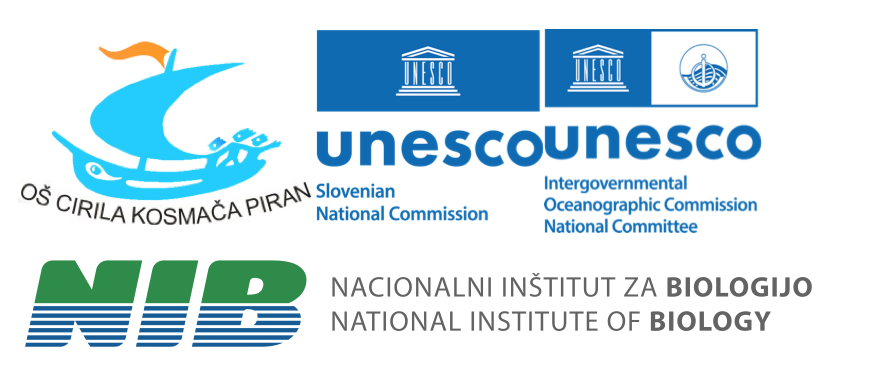
Elementary School Ciril Kosmač Piran (7 – 8 year old students, teachers Vika Kuštrin) Piran, Slovenia in collaboration with Marine Biology Station Piran, National Institute of Biology and their IOC UNESCO activities
Magic Beans in the Deep Sea
In the famous fairy tale magic beans grow into a huge beanstalk reaching to the clouds (Jack and the Beanstalk). Let’s see if our beans do the same at the bottom of the ocean.
Background:
We know that sprouting of bean seeds takes about a week. You either can put them directly in the soil or you can also put them between layers of paper and moist the paper. Then they will sprout but only at warm temperature, therefore seed should not sprout when it is too cold. It takes about a week for beans to sprout.
On March 16, 2011 the ship MS Oliva ran aground on Nightingale Island in the Atlantic Ocean. After all crew members were rescued, the ship broke up a few days later. The cargo was 60.000 tons of soy beans. Lots of oil was spilled into the ocean creating sever environmental damage. Beans were also spilled into the ocean but what happened to them was not further described. Six months later divers found rotten away bean areas in the ship wreck.
It is unknown whether beans can sprout in seawater. We also do not know if they sprout at high pressure in the deep sea.
Hypothesis: Beans will not sprout in cold, deep-sea water but will sprout in warm deep-sea water
Material and Methods: We will put beans between layers of paper and then place them in bags made out of panty hoses. For the deployment with the ROV we will mount a scuba diving lead on this bag with a rope, and to find the bag we will mount a lid of a plastic bucket on a second rope. Two of these bags will be deployed, one in warm vent water and one in a cold area. We will leave the bags in the deep sea for about 10 days. As control we also will put beans between layers of paper – moist them either with seawater or with freshwater and leave them at warm temperature in the lab. Another set we will put in the refrigerator.

Let’s see what happens with the beans in the deep sea and compare them to the beans in the lab.
On board we first repeated the experiments conducted by Elementary School Cirila Kosmača Piran on land. We exposed mixture of beans to freshwater and seawater and incubated them at room temperature or at 4°C in the dark and followed any signs of sprouting daily. We found out that only beans exposed to freshwater sprouted: first the ones at room temperature, but few days later also some from the batch incubated at 4°C. On the other hand, beans exposed to seawater did not show any sign of sprouting. Even more so, beans exposed to seawater at room temperature were covered in mold after 10 days.

(Top left) The four on board bean sprouting treatments (fresh and salt water, cold and room temperature). (Center left) Room temperature fresh water beans sprouted. (Center right) Room temperature salt water beans did not sprout, and grew some fungi. (Top right) Cold temperature salt water beans did not sprout either.
Next, we wrapped two batches of beans in two different bags with pores that allowed for water exchange and prepared them for the dive with ROV SuBastian from the Schmidt Ocean Institute.

(Top left) We use a mesh to wrap the beans. (Center left) They got wrapped in a bag. (Center right) Bean bag deployed in the deep ocean. (Top right) Bean bags back on board after recovery
They dived all the way through the water column, down to 2500 m depth, where we placed one bag in the vicinity of hydrothermal vent and the other away from it.

(Left) School experiments in the deep sea. (Center) SuBastian deploying the bag of beans. (Right) Bag of beans and the weight attached to it
We followed what was happening for the next 7 days. In fact, animals at the sea floor did not really care about the beans, so we brought them back to surface afterwards and repeated the experiment in the laboratory. We again exposed beans to freshwater and seawater and kept them at room temperature or at 4°C in the dark and followed any signs of sprouting daily. What happened? Again, unfortunately our beans did not like to journey so much as none of them showed any signs of sprouting. So, either beans were not magical or seawater and high pressure are not good conditions to cultivate your beans.

(Left) Beans from the depth. (Center) Once we opened the bag of beans. (Right) Salvador Espada and Tinkara Tinta

Elementary School Barbaraschool (10 – 11-year-old students, teacher Isabel Spruijt) Bunnik, Netherlands in collaboration with the Royal Netherlands Institute for Marine Research (NIOZ)
Part I: Under pressure!
Background:
Our bodies are adapted to the atmospheric pressure on Earth which is one 1 bar at sea level. You may have experienced a change of this pressure when you are sitting in an airplane and feel a “plop” in your ears as the pressure of the air on your inner year decreases when you ascend. When you jump into a swimming pool and dive to the bottom of the pool, the pressure increases with water depth and you can also feel this as your ears might start hurting as the water pushes against your inner ear.
In the sea, the pressure increases with 1 bar every 10 meters, which is a lot, as the water is much heavier than the air. Animals that live in the deep sea are adapted to this enormous pressure. When we perform our scientific experiments in the deep sea with submersibles or robots, the materials need to be strong enough to resist the pressure of the water. But how strong are the materials? What happens with “daily life” materials when they are exposed to the depths of our ocean?
Hypothesis: Materials that are filled with air are destroyed as the water pressure compacts them. Materials that are solid stay intact because they are not compressed by the water pressure.
Material and Methods: We thought about daily life materials where we want to know what happens with them under water pressure. The materials we want to test are: an air-filled balloon, a ping-pong ball, a raw egg, a cooked egg, pasta, eatable gummybears and marshmallows.
We want to mount these materials on the ROV platform and film it with the camera of the ROV while it is descending to 2500 meters water depth. Let’s see what happens!
Part II: Chef cook in the deep sea
Background: The fluids of the hydrothermal vents can reach really high temperatures, especially at the black smokers, where temperatures of above 300 degree Celsius can be measured.
Hypothesis: You can cook an egg or pasta or marshmallow in the hot vent fluids.
Material and Methods: In the first experiment we want to find out if an uncooked egg, marshmallows and pasta can resist the great pressure. If yes, we place the food into a steel-mesh that is mounted on a steel handle. The ROV-manipulator is then holding the steel-handle with the attached steel-mesh that is filled with the food for 10 minutes into hot vent fluids. Back on board of the ship, we will open the egg and taste the marshmallow and pasta if it they are well cooked. Enjoy!

Yeast Sees the Deep Sea (from a previous cruise)
Background: We know yeast because we use it to bake bread, to brew beer and to make wine and all this for already a few thousand years. However, that yeasts are living organisms was firstly described by Louis Pasteur (1822-1895) in his book “Études sur la bière“ (Studies about the beer). Yeasts are unicellular fungi, which grow to a size of 10 micrometer (a tenth part of a millimeter). Yeasts are heterotrophic that means they eat organic material (sugar, protein, fat) which is produced by other creatures. They use oxygen to break down sugar into water and carbon dioxide and they utilize the released energy for their metabolism. If there is no oxygen around, yeasts can live at least for some time and with less cell division. Then, the yeasts turn the sugar into the less energy rich ethyl alcohol (instead of water) and carbon dioxide. This is called fermentation. We utilize the carbon dioxide for example to let bread dough rise or to aerate beverage. The yeast itself provides us with vitamin B. Yeast extracts are used as flavor enhancer in food. In biotechnology sterile yeast extracts are used as culture media for other types of fungi or bacteria. Yeasts either reproduces by budding and cell division (asexual) or they produce spores (sexual).
Hypothesis: We hypothesized that yeast will survive in the deep sea, at least for some hours.
Material and Methods: We put bread dough containing living yeast into a container and mounted it outside of the submersible. The dive lasted 8 hours, the yeast was in a depth of 2500 meters for 5 hours. After the dive the ship’s cook made bread out the dough to see whether bread can be made of this dough indicating the yeast was surviving the pressure and cold conditions in the deep sea.

Yeast dough in open white container put into a blue plastic net and mounted to the outside of Alvin. After the dive we saw that the dough has increased in size a lot. Photographs: Bright lab.
Results: The cook took the dough that we recovered and immediately added flour to make bread. All of us tasted it and we found that it is not as airy and fluffily and as normal bread but it tasted like bread.

The ship’s cook made bread out the dough. Photographs: Bright lab
Conclusion: Yeast does not die because of the high pressure or darkness or low temperatures. At least not within 5 hours. Furthermore, the salty seawater does not harm the yeast.
We learned that plastic bags are not suitable as wrapping in the deep-sea, because they break. Moreover, the dough rose during the journey to the deep. Probably even several times and this is always bad for dough as the cook told us. The dough was relatively small when we took it out of the fridge. The outside temperature was already 25°C in the early morning. The water temperature at the surface was 28°C. This temperature continually decreases with increasing depth, but the yeast had enough time to become active when the bag was fixed to Alvin, during the descent and ascent of the submersible and during the recovery at the end of the dive.
The Styrofoam Experiment (from a previous cruise)
Background: Styrofoam is a synthetic material, brought onto the market by the German company BASF as early as 1951. The base materials are small pearls of Polystyrol, which is obtained from crude oil in a very complicated procedure. The pearls gets foamed with the aid of foaming agent and heat and gets turned into small pellets. These pellets can be forced out into almost any shape with heat and pressure. The complete Styrofoam comprises 98% air. It is very suitable as packing and insulation material. many items of daily life are made out of Styrofoam. For example, decorations and party cups.
Hypothesis: We hypothesized that Styrofoam cups change under pressure.
Material and Methods: To find out what happens with Styrofoam cups under pressure we took some of these cups with us into the depth. To keep their shapes, we stuff them tightly with paper towels. The submersible pilot fixed one of the cups on Alvin’s basket and aimed one camera at it, before the dive.
Results and Conclusion: The Styrofoam cups got considerably smaller under high pressure. This happened because the air got compressed when under pressure during the descent of the submersible. Note that liquids and solids do not get compressed with pressure, while gases react differently.
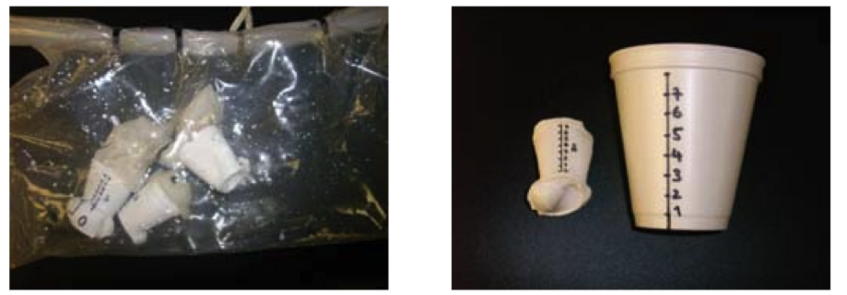
1. Cups after the after dive. 2. Comparison after and before dive. Photographs: Bright lab.
